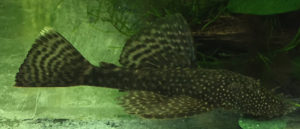Scientific Name Ancistrus Cirrhosus
Family Loricariidae
pH 5.8 – 7.5
dH 4 – 16
Temp 22 – 27 degrees
Life Span 5+ years
Origin
The Bristlenose Catfish originates from South America in Brazil’s Rio Negro Basin.
Description
The Bristlenose is from the Loricariidae family. They will grow up to 10 -13cm in length. Its most distinguishing feature is the Bristle-like tentacles on the top of its head. Brown bony plates cover the body with a pattern of lighter coloured spots. It’s large mouth is common for Loricariids.This mouth helps them latch on and anchor themselves to rocks or driftwood in flowing rivers or stream where the current is strong. Sexing the Bristlenose is easy. Only the male has the bristle-like tentacles on its head while the female may have smaller tentacles around their mouth or none at all. They also have Bristles near their gills that when flared look like small tusks. The Bristlenose Catfish can also be named Bristlenose Pleco, Sukermouth Catfish or Bushy Nose Catfish. It is one of the most common Catfish in the aquarium.
Environment
The Bristlenose is mainly a bottom dweller, although will be found attaching itself to different areas on the glass of the tank. A fast flowing current is favoured but not essential. Provide well oxygenated water with rocks and driftwood ensuring there are enough places to hide. Bristlenose Catfish need driftwood as part of their nutritional diet. They will knaw off tiny fragments of wood with their teeth. This helps them with their digestion process.
Behaviour
Bristlenose Catfish are great to keep in a community fish tank as they are peaceful toward other fish. They are territorial about their own space and like to spend time foraging for food. They constantly eat algae which helps to clean the aquarium. They occasionally fight with other males, but can be kept well together. Be careful when netting them, because their small tusks flare when agitated. This can get them quite entangled.
Food
The Bristlenose is an omnivore and is not to fussy about what it eats. Along with eating algae in the aquarium, it will eat a wide variety of food. Algae wafers, flake food, vegetables like cucumber, zucchini, spinach, lettuce, broccoli, peas and green beans. Also bloodworms and other foods rich in protein. The beauty about the Bristlenose is that it won’t take a precedence over certain foods and will continue to eat algae throughout the aquarium. The Bristlenose will not harm your aquarium plants.
Disease
There are no specific diseases that directly affect this species but they are prone to the variety of others.
Breeding
To begin with the male will become busy cleaning a spot in the tank usually under driftwood or rocks, or in a cave. He can become quite territorial at this time towards other fish. The male will entice the female back to its space once the nest is ready. A female will lay her eggs with the male fertilizing them. The male will watch over the eggs and fan water over them. The fry will hatch in about 5 days and then be free swimming within about a week.

